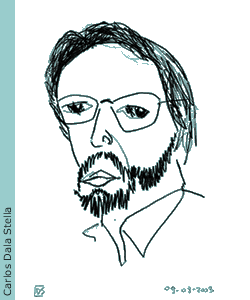 |
WORLD LITERATURE TODAY
A literary quarterly of the university of Oklahoma
Norman, Oklahoma / USA
AUTUMN 1992 issue
Malcolm Silverman
San Diego State University
Cristovão Tezza. A Suavidade do Vento.
Rio de Janeiro. Record. 1991. 204 pages.
Although similarities in characterization, thesis, structure,
and even hermeticism are present in some of his previous works
- notably, Ensaio da Paixão (1986), Trapo
(1988), Aventuras Provisórias (1989), and
Juliano Pavollini (1989), Cristovão Tezza (b. 1952)
opts to broaden his style considerably in his new novel. Indeed,
A Suavidade do Vento (The softness of the Wind) proves
to be a multitiered gybrid of theater and prose, realism and fantasy,
tragedy and comedy, and especially fiction and metafiction. This
unabashed confluence of styles and genres, in turn, is diffused
through moody introspection and stagnant confines.
From the outset Tezza blurs the divide between reader (spectator)
and writer (narrator), crator and created, truth and invention.
The novel's title, for instance, is also taht of his protagonist-writer's
opus, just as Tezza's general autobiographical coordinates mirror,
if in a distorted manner, the chracter's very curriculum vitae.
Meanwhile, all along, the narrator intermingles freely with reader
and personae alike, and the protagonist insists on using several
variations on his name.
The novelist begins A Suavidade do Vento with a half-page
prólogo, quick to establish a sense of inverted stage convention
whereby the absurd is rendered matter-of-fact. Here the narrator
is a bus driver, releasing his (at this point) anonymous rider-characters
in the middle of nowhere. In the final three-page cortina (curtain)
which closes the narrative, the metaphoir is expanded and the
voyage motif is concluded: the return trip (to oblivion) gets
under way, this time with whe whole "cast" now identified
by (nick)name.
It is the first-person narrator, obstrusive and o unproven reliability,
who details the thoughts and behavioral patterns which join to
produce the plot thread - i.e., the daily anguish of the thin,
sickly looking protagonist. He is Matozo, a solitary, insecure,
even paranoid provincial grammar teacher. Furthermore, he is characterized
by a near-pathological attachment to tobacoo, liquor, and gambling;
an obsession with becoming a writer; a virginal awe of women;
chronic (psychosomatic?) vertigo and neck pains; and uneasy cohabitation,
as it were, with little invisible monsters who delight in his
unstable, seemingly worsening mental condition.
As with some laboratory rat, Tezza's narrator submerges Matozo
in total inner and outer adversity, indeed oppressiveness; then
he proceeds to magnify the protagonist's modus vivendi, placing
him in and around a small Paraná town during a rather well-delineated
period (late 1971). There is, for example, his brooding over finishing,
publishing, and promoting a first novel, a pastime soon substituted
by oil painting; his escapist forays to Paraguayan casinos; and
a climactic sojourn in more cosmopolitan Curitiba, from where
he returns home, a reborn prodigal son, to a surprising tabula
rasa of radical rethinking on the part of former acquaintances.
In the process, by covering previous lies with new ones, he dramatically
renounces his artistic inclinations, in effect rebuking as well
his own self-identity. Already in peril, this shattered ego had
long since hinged, most notably, on a defensive outpouring of
ubiquitous quotes from the I Ching and Clarice, inserted in italics
at every turn.
Matozo's propensity for remorse and merciless self-criticism at
once forms a multiple thematic vehicle. Through it, Tezza ponders
the relevance of literature in society just as he takes to task
the prostrate role of author, any author. In one instance of implicit
criticism, during the author Matozo's only promotional interview
- packed with false responses to cliché-ridden questions
- he is asked about, and made to think, if only in passing, of
the military repression all too common during the period. No wonder
a title like "The softness of the Wind" seems cruelly
misplaced, unlike "The Dust and the Darkness", a hypothetical
second work with which Matozo fleetingly toys. Meanwhile, Matozo's
twisted trajectory allows for explicit (metaficcional) metaphor
as well, periodically echoed by narrator and protagonist alike.
Throughout, the entire narrative ebbs and flows in a contrastive
rhythm of animated dialogues and depressing intimist thought.
Heavy in symbolically named peripheral figures as well as surrealistic
resolution, A Suavidade do Vento is, at the same time, a simple
yet very universal parable. After all, passing mention of Fellini
and Borges, Dostoevsky and Verissimo, among others, never detracts
from an all-compelling message regarding human solitude. Matozo,
for example, goes from inwardly correcting others' poor grammar,
as a way of secretly avenging their condescension toward him,
to authoring a newspaper column on the same object, but now for
all his newfound admirers to read.
Attention to detail is enhanced by ample simile and tempered by
occasional (caustic) humor. Repeated recourse to "aggressive",
comic-book-like capitalization and, above all, to an engaging
story-within-a-story format further enriches this innovative,
secondhand catharsis and helps register A Suavidade do Vento
as a sound addition to Cristovão Tezza's already promising
bibliography.
 voltar voltar
|